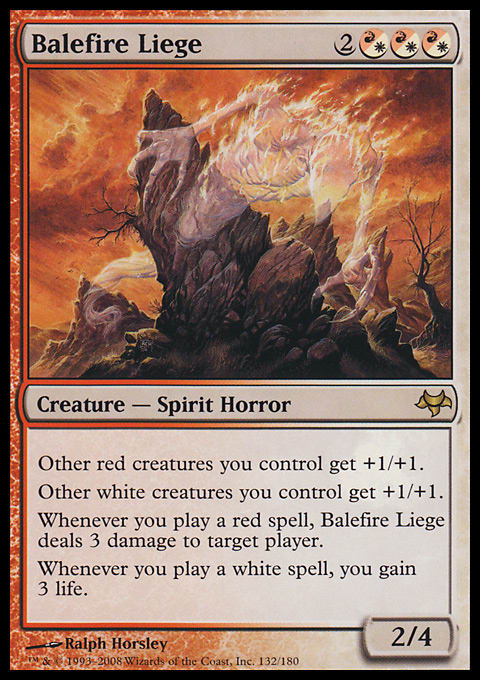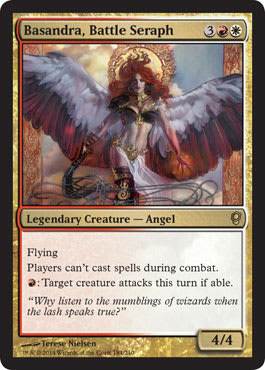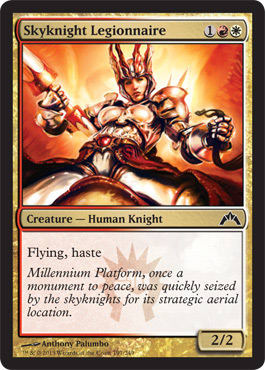– Oxford Companion to American Military History | 2000 | John Whiteclay Chambers II
When you have a play style like mine, playing a Boros deck in multiplayer can be a tricky thing. Boros cards are intended to be played in a deck that rushes out quickly with many inexpensive creatures, trying to overwhelm the opponent before he can really set up any kind of defense. Most Boros decks include some way to deal the final points of damage, whether it be with some large X spell, bigger creatures, or a Fling-style card that uses up those small creatures. Boros smashes face and does it quickly.
When Boros is played in multiplayer games, you can’t expect a weenie rush, followed up by a few points of damage in another way, to ever get the job done to every opponent. The Boros player also doesn’t have many ways to ramp, so the deck’s creatures are often outsized by anyone playing green and/or black. This often leads to Boros players running several pieces of Equipment to equalize the board. Boros players attempt to rush quickly and then reset the board when the board is stacked against them. Their creatures are cheaper and that, coupled with Equipment, gives them several turns with their regained advantage. Out comes another board sweeper. Lather, rinse, repeat.
In multiplayer, Boros decks also tend to have a higher mana curve. White and red offer a nice suite of creatures at higher mana costs. This allows them to reset less often and forces their opponents to commit to the board every time rather than be able to try to hold back and prepare for the next board sweeper.
This play style demands you step up and take the game by the horns. You want to hit first, hit hard, and keep hitting, holding off on the reset button until the time is just right for you. Part of the success of this style is dependent on you controlling the game. You are forcing opponents to play their spells and creatures. You are saying when everyone will be starting again. You know what is going to happen and when it will happen while your opponents are left wondering. If the game reaches a point at which you have lost control, and a reset button is going to leave you just as far behind as you would be otherwise, you have lost control and will probably need help winning the game.
My preferred play style is to lay low as much as possible. I want my opponents to do most of the work for me, killing each other and using up their valuable resources doing it. I want to play out just enough threats to not be a threat or a target. Much like usual Boros decks, I need to control the board if I intend to win. Unlike usual Boros decks, I generate that control by encouraging my opponents to attack each other. Usual Boros decks win by forcing everyone else to act in a particular way. My play style wins by making the actions I desire appear to be the actions the other players desire as well. Given all of this, you can see how the usual Boros deck doesn’t coincide with my play style.
In spite of that, I really enjoy the color combination. I like being able to deal with most permanents on the battlefield while playing with aggressively costed creatures. Typically, my R/W decks are not “Boros” decks. My latest attempt was my Form of the Dragon deck that I talked about last year. I build with the Boros colors, but I’m not building a Boros deck.
It’s time to change that.
But how do you use the Boros army without completely drawing attention to oneself throughout the entire game? I’m looking to shift from the full-frontal assault of the usual Boros deck to more guerrilla tactics.
"Boros Irregulars"
- Creatures (28)
- 1 Boros Guildmage
- 1 Duergar Mine-Captain
- 1 Knight of Obligation
- 2 Basilica Guards
- 2 Skyknight Legionnaire
- 2 Soltari Guerrillas
- 2 Stun Sniper
- 2 Thundersong Trumpeter
- 4 Balefire Liege
- 4 Duergar Hedge-Mage
- 3 Solemn Simulacrum
- 1 Basandra, Battle Seraph
- 1 Gisela, Blade of Goldnight
- 2 Brion Stoutarm
- Planeswalkers (1)
- 1 Ajani Vengeant
- Spells (9)
- 1 Double Cleave
- 1 Guerrilla Tactics
- 1 Intimidation Bolt
- 1 Master Warcraft
- 1 Squee's Embrace
- 4 Boros Signet
- Lands (22)
- 4 Mountain
- 4 Plains
- 1 Slayers' Stronghold
- 1 Winding Canyons
- 4 Clifftop Retreat
- 4 Plateau
- 4 Sacred Foundry
Boros Guildmage, Stun Sniper, Thundersong Trumpeter – There is nothing saying that your creatures always have to be the ones receiving haste or first strike from the Guildmage! Giving first strike to an opponent’s creatures that are attacking another opponent, after blockers have been declared, can completely mess up the math. The Stun Sniper can let you tap out Opponent A’s blocker right before Opponent B is about to declare attackers. Admittedly, it isn’t exactly subtle, but if you have read Opponent B’s wishes accurately, you may have done a lot more than a single damage to a creature.
Balefire Liege, Brion Stoutarm, Basilica Guards, Knight of Obligation – These are the cards that make this deck far more guerrilla-like than the usual Boros deck. The Liege and Stoutarm limit how much you are directly attacking each opponent, instead allowing you to wait until the last moments before casting spells or tapping them out to do the damage. Anyone who has played against these cards knows that the damage they deal can add up very quickly.
I know, Basilica Guards and Knight of Obligation are using the Orzhov’s extort mechanic. The problem is that it fits perfectly into what I am trying to do with this deck! Don’t think of it as extortion, but more like traps, timed to go off on unsuspecting opponents. In multiplayer games, these extort triggers will be annoying but—with the limited use they’ll have here—not too annoying.
Soltari Guerrillas – While the Liege, Stoutarm, and others don’t target the problematic creatures, this card does, and does it beautifully. Even if shadow creatures are in your playgroup, it doesn’t matter. If one person is open, you can attack him and then redirect the damage to any creature, not just a creature that opponent controls. This lets you kill those annoying creatures that never block or the creatures of a player who has multiple Propagandas and/or Ghostly Prisons that you can’t afford to pay for.
The key is to use this card judiciously. Sometimes, you don’t want to take out the best creature, you simply want to take out the deathtouch creature that is stopping everyone from attacking someone else. Too many times, I have caught myself using this type of effect to make my next attack better. Let your opponents do your work!
And besides, how can I not use Soltari Guerrillas in the deck?
Duergar Mine-Captain – I like the idea of giving a bonus to attacking creatures, especially when they aren’t attacking me. I have used the untap mechanic to some success in some decks, while it has crashed and burned in others. This is very much a try-and-see-how-it-works pick for the deck.
Basandra, Battle Seraph – While Basandra’s is probably among the best pieces of art in Magic, the actual card is much maligned. There always seems to be a better card to run instead. Even in this deck, she can be a nonbo with many of the noncreature spells in the deck. In spite of this, I like her in the deck. Limiting what others can do during combat means that you have a much better idea what your effects will do. You aren’t accidentally doing damage to a creature only to have it avoid dying in some unforeseen way. The ability to force an attack is solid as well. An attacking creature is not generally a blocking creature, and that is a good thing. The creature isn’t forced to attack you, either, so if the attack kills a creature or does damage to an opponent, the outcome is usually good.
Gisela, Blade of Goldnight – This is probably the card I’m most worried about. When opponents see Gisela, many of them understand that the game should now be about killing you or killing Gisela. In spite of that, I’m running her anyway. All it means is that I need to be extremely judicious about when Gisela enters the battlefield. If there is a clear threat that isn’t you, running out this card will probably mean some cheers. Other players will just like the idea of doubling their damage and go attack someone else. Get a read for your board state, and make the decision. It can be painful to leave it in hand when you could play it, but the alternative could be even worse.
Duergar Hedge-Mage – This may not seem like much, but the ability to take out an artifact or enchantment, in my metagame, has been growing more and more important. This card lets me do that, gives me a bonus 2/2 creature, and can activate the Balefire Liege for bonus damage and life-gain. Your metagame may not require four copies, but I’ll stick with it.
Skyknight Legionnaire – Running hasty flyers always seems like a good idea. I recommend going with the old-school version. Far more inspiring for your troops!
Ajani Vengeant – Don’t try to pile up the tokens on this planeswalker. Everyone needs to understand you are not trying to ultimate him. I have seen plenty of these guys stay on the battlefield a long time, tapping creatures and throwing sorcery-speed Lightning Helixes around. Try taking all of one player’s lands away, and see how that works for you. That sort of play will make you a target all night long.
Double Cleave, Intimidation Bolt, Master Warcraft – These are all about messing with your opponents’ combats. If Master Warcraft is used correctly, you should be able to remove at least one opponent from the game. Remember that choosing not to block is a legal move!
As you can see, while you could try to win by just attacking outright, that really isn’t the point of the deck. The deck uses a three-pronged attack:
- Creatures – It would be crazy to run a Boros deck and not attack at all. Your creatures are not spectacular on the attack, though, so most times, attacks will come when your opponents aren’t expecting it. Perhaps it is through a creature flashed into play with Winding Canyons or an opening created through your other cards. Relying completely on your creatures heading into the red zone to earn wins would be foolhardy with this deck, but believing you could do it without them is questionable as well.
- Damage – The multicolored spells are there to work with Balefire Liege, one of the only cards in the deck with four copies. The Liege, Brion Stoutarm, and Ajani Vengeant, will all be expected to do damage when needed.
- Opponent vs. Opponent – You will want to encourage them to attack each other. Whether it is by preventing a creature from blocking, giving a creature haste or first strike, or by some other means, you will want to do what you can to ensure your opponents attacks are vicious—even if they didn’t mean them to be.
Not every Boros deck needs to involve you moving massive troops about the battlefield. Guerrilla warfare can be effective, even in Magic.
Bruce Richard






























